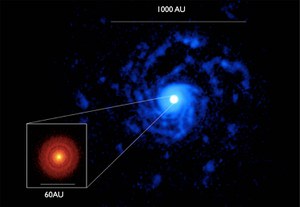Large-scale Gas Distribution Around Protoplanetary Disks
 While protoplanetary disks often appear to be compact and well organized in millimeter continuum emission, CO spectral line observations are increasingly revealing complex behavior at large distances from the host star. Huang et al. present deep ALMA maps of the J = 2−1 transition of 12CO, 13CO, and C18O, as well as the J = 3−2 transition of DCO+, toward the T Tauri star RU Lup at a resolution of ~0.3 arcseconds (~50 AU). The CO isotopologue emission traces four major components of the RU Lup system: (1) a compact Keplerian disk with a radius of ~120 AU; (2) a non-Keplerian "envelope-like" structure surrounding the disk and extending to ~260 AU from the star; (3) at least five blueshifted spiral arms stretching up to 1000 AU; and (4) clumps outside the spiral arms located up to 1500 AU in projection from RU Lup. The authors comment on potential explanations for RU Lup's peculiar gas morphology, including gravitational instability, accretion of material onto the disk, or perturbation by another star. RU Lup's extended non-Keplerian CO emission, elevated stellar accretion rate, and unusual photometric variability suggest that it could be a scaled-down Class II analog of the outbursting FU Ori systems.
While protoplanetary disks often appear to be compact and well organized in millimeter continuum emission, CO spectral line observations are increasingly revealing complex behavior at large distances from the host star. Huang et al. present deep ALMA maps of the J = 2−1 transition of 12CO, 13CO, and C18O, as well as the J = 3−2 transition of DCO+, toward the T Tauri star RU Lup at a resolution of ~0.3 arcseconds (~50 AU). The CO isotopologue emission traces four major components of the RU Lup system: (1) a compact Keplerian disk with a radius of ~120 AU; (2) a non-Keplerian "envelope-like" structure surrounding the disk and extending to ~260 AU from the star; (3) at least five blueshifted spiral arms stretching up to 1000 AU; and (4) clumps outside the spiral arms located up to 1500 AU in projection from RU Lup. The authors comment on potential explanations for RU Lup's peculiar gas morphology, including gravitational instability, accretion of material onto the disk, or perturbation by another star. RU Lup's extended non-Keplerian CO emission, elevated stellar accretion rate, and unusual photometric variability suggest that it could be a scaled-down Class II analog of the outbursting FU Ori systems.
Figure caption: ALMA CO 2-1 (blue) and 230 GHz dust (red) emission at 0.3 arcsec resolution of the protoplanetary disk around RU Lupus.
Publication: Jane Huang et al.. Large-scale CO Spiral Arms and Complex Kinematics Associated with the T Tauri Star RU Lup, Astrophysical Journal, 898, 140 (3 August 2020).
NRAO Press Release: ALMA Captures Stirred-Up Planet Factory




Connect with NRAO